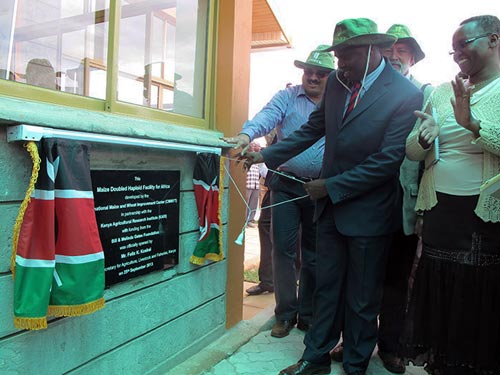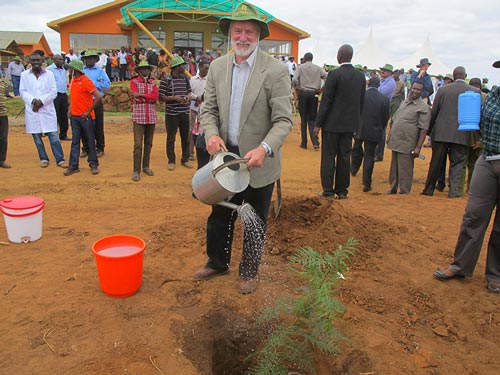By Miriam Shindler/CIMMYT

CIMMYT, in partnership with the Kenya Agricultural Research Institute (KARI), established two major maize facilities in Kenya last week. The Maize Doubled-Haploid Facility for Africa at KARI-Kiboko aims to accelerate the development of stress-resilient and nutritionally-improved maize varieties while the Maize Lethal Necrosis Screening Facility at KARI-Naivasha will focus on tackling deadly maize lethal necrosis (MLN).
The doubled-haploid (DH) facility, established with funding support from the Bill & Melinda Gates Foundation, was inaugurated on 25 September by Felix K. Koskei, Kenya’s cabinet secretary for Agriculture, Livestock and Fisheries. Representatives from the ministry and country government, the CIMMYT board of trustees and management committee and the KARI director and board of management attended the inauguration. “Just as agriculture is the driver of economic growth, so is agricultural research the engine of agriculture,” Koskei said. “I take this opportunity to congratulate maize research scientists for their tireless efforts in conducting cutting-edge agricultural research directed at solving the constraints that hinder agricultural growth.”
The facility will help serve African agriculture for years to come, said CIMMYT Director General Thomas Lumpkin. “The Maize DH Facility will be key to fast-tracking the development and delivery of drought tolerant, disease and insectpest resistant and nutritionally enriched maize varieties for the benefit of Kenyan and African farmers at large,” he said. The MLN screening facility will address another challenge: while maize is Africa’s most important food crop, the 2011 drought in East Africa – combined with the emergence of MLN in eastern Africa in 2012 – resulted in significant crop losses and severe food shortages across the region. The accelerated development and delivery of MLNresistant maize varieties with other important adaptive traits is an urgent priority for CIMMYT and its partners in the region. The MLN Screening Facility at KARI-Naivasha is central to achieving this goal and was made possible with funding support from the Bill & Melinda Gates Foundation, and the Syngenta Foundation for Sustainable Agriculture.

Inaugurating the MLN Screening Facility at KARI-Naivasha, Kenya’s Principal Secretary to the Ministry of Agriculture Sicily Kariuki commended CIMMYT and KARI for their rapid response to MLN and for establishing a screening facility that will benefit the entire region. The facility aims to provide MLN phenotyping services and effectively manage the risk of MLN on maize production through screening and identifying MLNresistant maize germplasm. It will make use of public and private sector research partners in Africa to contribute to food security and to the livelihoods of farming communities in Eastern Africa. Through the KARI-CIMMYT partnership, several promising maize inbred lines and hybrids with resistance to MLN have Photo: Florence Sipalla already been identified and are being further validated and used in breeding strategies to develop MLN-resistant maize hybrids. Prasanna Boddupalli, director of the CIMMYT Global Maize Program, emphasized the facility “will serve not only CIMMYT and KARI, but other interested public and private sector institutions that are engaged in developing and delivering improved maize varieties to farmers in Africa.”
 Climate adaptation and mitigation
Climate adaptation and mitigation 
